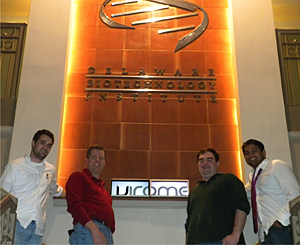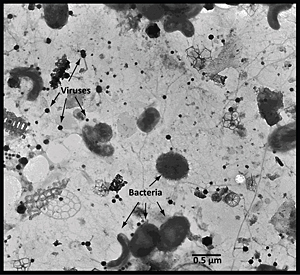
ADVERTISEMENT
- Rozovsky wins prestigious NSF Early Career Award
- UD students meet alumni, experience 'closing bell' at NYSE
- Newark Police seek assistance in identifying suspects in robbery
- Rivlin says bipartisan budget action, stronger budget rules key to reversing debt
- Stink bugs shouldn't pose problem until late summer
- Gao to honor Placido Domingo in Washington performance
- Adopt-A-Highway project keeps Lewes road clean
- WVUD's Radiothon fundraiser runs April 1-10
- W.D. Snodgrass Symposium to honor Pulitzer winner
- New guide helps cancer patients manage symptoms
- UD in the News, March 25, 2011
- For the Record, March 25, 2011
- Public opinion expert discusses world views of U.S. in Global Agenda series
- Congressional delegation, dean laud Center for Community Research and Service program
- Center for Political Communication sets symposium on politics, entertainment
- Students work to raise funds, awareness of domestic violence
- Equestrian team wins regional championship in Western riding
- Markell, Harker stress importance of agriculture to Delaware's economy
- Carol A. Ammon MBA Case Competition winners announced
- Prof presents blood-clotting studies at Gordon Research Conference
- Sexual Assault Awareness Month events, programs announced
- Stay connected with Sea Grant, CEOE e-newsletter
- A message to UD regarding the tragedy in Japan
- More News >>
- March 31-May 14: REP stages Neil Simon's 'The Good Doctor'
- April 2: Newark plans annual 'wine and dine'
- April 5: Expert perspective on U.S. health care
- April 5: Comedian Ace Guillen to visit Scrounge
- April 6, May 4: School of Nursing sponsors research lecture series
- April 6-May 4: Confucius Institute presents Chinese Film Series on Wednesdays
- April 6: IPCC's Pachauri to discuss sustainable development in DENIN Dialogue Series
- April 7: 'WVUDstock' radiothon concert announced
- April 8: English Language Institute presents 'Arts in Translation'
- April 9: Green and Healthy Living Expo planned at The Bob
- April 9: Center for Political Communication to host Onion editor
- April 10: Alumni Easter Egg-stravaganza planned
- April 11: CDS session to focus on visual assistive technologies
- April 12: T.J. Stiles to speak at UDLA annual dinner
- April 15, 16: Annual UD push lawnmower tune-up scheduled
- April 15, 16: Master Players series presents iMusic 4, China Magpie
- April 15, 16: Delaware Symphony, UD chorus to perform Mahler work
- April 18: Former NFL Coach Bill Cowher featured in UD Speaks
- April 21-24: Sesame Street Live brings Elmo and friends to The Bob
- April 30: Save the date for Ag Day 2011 at UD
- April 30: Symposium to consider 'Frontiers at the Chemistry-Biology Interface'
- April 30-May 1: Relay for Life set at Delaware Field House
- May 4: Delaware Membrane Protein Symposium announced
- May 5: Northwestern University's Leon Keer to deliver Kerr lecture
- May 7: Women's volleyball team to host second annual Spring Fling
- Through May 3: SPPA announces speakers for 10th annual lecture series
- Through May 4: Global Agenda sees U.S. through others' eyes; World Bank president to speak
- Through May 4: 'Research on Race, Ethnicity, Culture' topic of series
- Through May 9: Black American Studies announces lecture series
- Through May 11: 'Challenges in Jewish Culture' lecture series announced
- Through May 11: Area Studies research featured in speaker series
- Through June 5: 'Andy Warhol: Behind the Camera' on view in Old College Gallery
- Through July 15: 'Bodyscapes' on view at Mechanical Hall Gallery
- More What's Happening >>
- UD calendar >>
- Middle States evaluation team on campus April 5
- Phipps named HR Liaison of the Quarter
- Senior wins iPad for participating in assessment study
- April 19: Procurement Services schedules information sessions
- UD Bookstore announces spring break hours
- HealthyU Wellness Program encourages employees to 'Step into Spring'
- April 8-29: Faculty roundtable series considers student engagement
- GRE is changing; learn more at April 15 info session
- April 30: UD Evening with Blue Rocks set for employees
- Morris Library to be open 24/7 during final exams
- More Campus FYI >>
3:08 p.m., March 17, 2011----The positive genetic contributions of viruses to life on Earth will be explored by researchers at the University of Delaware and the Delaware Biotechnology Institute through a grant from the Gordon and Betty Moore Foundation Marine Microbiology Initiative.
The two-year, $550,000 grant has been awarded to K. Eric Wommack, professor in UD's Department of Plant and Soil Sciences with appointments in the Department of Biological Sciences and the College of Earth, Ocean, and Environment, and Shawn Polson, research assistant professor in the Center for Bioinformatics and Computational Biology at DBI.
The grant will support the rollout of a computational infrastructure dedicated to the analysis of viral genetic data from environmental samples. The Viral Informatics Resource for Metagenome Exploration (VIROME) is hosted at DBI.
The project will be done in collaboration with researchers at the University of California, San Diego (UCSD), involved with the Community Cyberinfrastructure for Advanced Marine Microbial Ecology Research and Analysis (CAMERA) project, a web-based resource for advancing metagenomic research.
The Marine Microbiology Initiative at the Gordon and Betty Moore Foundation recently expanded to include the study of viruses, and scientists now appreciate that viruses contain perhaps the largest collection of unknown genes on earth. Wommack's research specifically focuses on the positive genetic contributions viruses make to life -- an aspect of viruses that has not yet been widely studied.
“We really don't appreciate the genetic contributions viruses make to life other than the negative ones,” says Wommack. “This grant will allow us to explore this facet of viruses in marine ecosystems -- and we've already begun to find surprising results.”
Through the study of deep sea hydrothermal vents, uranium contaminated groundwater, Chesapeake Bay water and other hotbeds for viruses, Wommack's team has discovered that viruses contain completely novel versions of genes with well-known functions.
These discoveries come from the study of marine ecosystems but allow researchers to learn more about the predominant biological features of viruses overall, which can affect how human conditions - such as cancer - are diagnosed and treated.
“Within some of the virus samples we've collected, we found genes critical to protein folding,” says Polson. “In many cases, protein has to be directed to fold in the proper way. Protein misfolding is a component in the cause of some diseases, so this knowledge can be very important in our understanding of viral infection processes.”
The data aspect of this grant is essential in helping scientists learn more about the genetic makeup of viruses so that they can better understand their positive contributions.
Jaysheel Bhavsar, a master's student in computer and information sciences, has been the lead on the web application interface that translates the genetic information into understandable data. Dan Nasko, a master's student in bioinformatics, will be interfacing with the users of VIROME and working data through the computational pipeline.
Wommack and Polson describe virus genetic sequence data as an unedited book containing sophisticated vocabulary without page numbers, punctuation, or even spaces between sentences or words -- basically a string of letters with no meaning.
But in fact, the strings of letters have significant meaning, as this is the genetic instruction set for how viruses control and ultimately kill the cells they infect.
The database they've created, along with the web application interface, will in essence help scientists punctuate DNA sequence data into “words,” “sentences,” “paragraphs” and even “chapters,” if you will, to aid in the process of understanding the important role viruses play in controlling cellular life on earth.
“What we've created, with the support of the CAMERA technology from UCSD, is a way to translate raw information -- virus genome data -- into useful genetic information,” says Wommack. “And our web application interface provides the 'books' -- just like shopping on Amazon.com -- complete with a picture of the book's 'cover,' the 'price,' the 'authors,' etc. It pulls the translated information about the viruses from the database and presents it in graph and other data formats for consumption.”
The VIROME web application and sequencing libraries are available online for use for free now at this website.
Article by Laura Crozier



